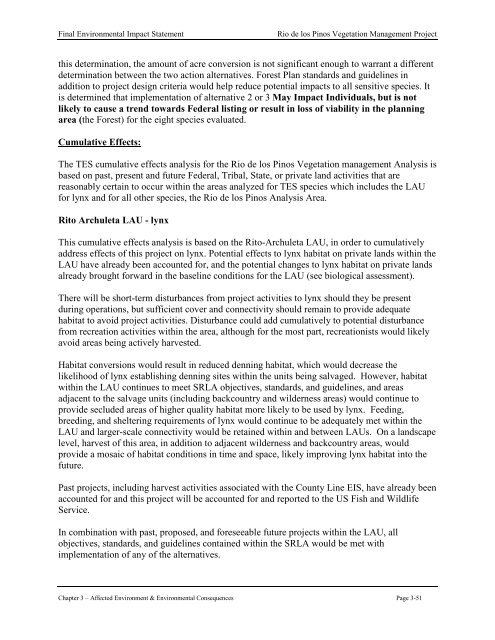Final Environmental Impact Statement Rio de los Pinos Vegetation ...
Final Environmental Impact Statement Rio de los Pinos Vegetation ...
Final Environmental Impact Statement Rio de los Pinos Vegetation ...
Create successful ePaper yourself
Turn your PDF publications into a flip-book with our unique Google optimized e-Paper software.
<strong>Final</strong> <strong>Environmental</strong> <strong>Impact</strong> <strong>Statement</strong> <strong>Rio</strong> <strong>de</strong> <strong>los</strong> <strong>Pinos</strong> <strong>Vegetation</strong> Management Project<br />
this <strong>de</strong>termination, the amount of acre conversion is not significant enough to warrant a different<br />
<strong>de</strong>termination between the two action alternatives. Forest Plan standards and gui<strong>de</strong>lines in<br />
addition to project <strong>de</strong>sign criteria would help reduce potential impacts to all sensitive species. It<br />
is <strong>de</strong>termined that implementation of alternative 2 or 3 May <strong>Impact</strong> Individuals, but is not<br />
likely to cause a trend towards Fe<strong>de</strong>ral listing or result in <strong>los</strong>s of viability in the planning<br />
area (the Forest) for the eight species evaluated.<br />
Cumulative Effects:<br />
The TES cumulative effects analysis for the <strong>Rio</strong> <strong>de</strong> <strong>los</strong> <strong>Pinos</strong> <strong>Vegetation</strong> management Analysis is<br />
based on past, present and future Fe<strong>de</strong>ral, Tribal, State, or private land activities that are<br />
reasonably certain to occur within the areas analyzed for TES species which inclu<strong>de</strong>s the LAU<br />
for lynx and for all other species, the <strong>Rio</strong> <strong>de</strong> <strong>los</strong> <strong>Pinos</strong> Analysis Area.<br />
Rito Archuleta LAU - lynx<br />
This cumulative effects analysis is based on the Rito-Archuleta LAU, in or<strong>de</strong>r to cumulatively<br />
address effects of this project on lynx. Potential effects to lynx habitat on private lands within the<br />
LAU have already been accounted for, and the potential changes to lynx habitat on private lands<br />
already brought forward in the baseline conditions for the LAU (see biological assessment).<br />
There will be short-term disturbances from project activities to lynx should they be present<br />
during operations, but sufficient cover and connectivity should remain to provi<strong>de</strong> a<strong>de</strong>quate<br />
habitat to avoid project activities. Disturbance could add cumulatively to potential disturbance<br />
from recreation activities within the area, although for the most part, recreationists would likely<br />
avoid areas being actively harvested.<br />
Habitat conversions would result in reduced <strong>de</strong>nning habitat, which would <strong>de</strong>crease the<br />
likelihood of lynx establishing <strong>de</strong>nning sites within the units being salvaged. However, habitat<br />
within the LAU continues to meet SRLA objectives, standards, and gui<strong>de</strong>lines, and areas<br />
adjacent to the salvage units (including backcountry and wil<strong>de</strong>rness areas) would continue to<br />
provi<strong>de</strong> seclu<strong>de</strong>d areas of higher quality habitat more likely to be used by lynx. Feeding,<br />
breeding, and sheltering requirements of lynx would continue to be a<strong>de</strong>quately met within the<br />
LAU and larger-scale connectivity would be retained within and between LAUs. On a landscape<br />
level, harvest of this area, in addition to adjacent wil<strong>de</strong>rness and backcountry areas, would<br />
provi<strong>de</strong> a mosaic of habitat conditions in time and space, likely improving lynx habitat into the<br />
future.<br />
Past projects, including harvest activities associated with the County Line EIS, have already been<br />
accounted for and this project will be accounted for and reported to the US Fish and Wildlife<br />
Service.<br />
In combination with past, proposed, and foreseeable future projects within the LAU, all<br />
objectives, standards, and gui<strong>de</strong>lines contained within the SRLA would be met with<br />
implementation of any of the alternatives.<br />
Chapter 3 – Affected Environment & <strong>Environmental</strong> Consequences Page 3-51
















